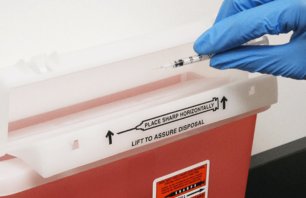Boise Medical Waste Disposal and Compliance Solutions
Medical Waste Disposal Solutions Near Boise
From Mountain Home to Nampa and beyond, we are here to help Idahoans protect what matters with medical waste disposal solutions to match your needs.
When you choose Stericycle, you’re selecting a partner with the resources to stand by your healthcare practice when things are easy and when they’re hard. Our services are designed to offer you convenience and compliance, so you can get back to keeping your facility running smoothly
We service facilities of all sizes and are in compliance with all State and Federal waste management regulations.
With over 30 years of experience, Stericycle provides essential services that help protect communities from harmful wastes, promote access to healthcare services, and lead to greater consumer safety and satisfaction.
Our suite of services includes:
- Biohazardous Medical Waste Disposal – specialized solutions to manage the collection, transportation, treatment, pickup and disposal of biohazardous waste streams for facilities of all sizes in your local area
- HIPAA and OSHA Compliance Training – customized on-site and on-demand web-based training resources to help ensure facility and staff compliance
- Pharmaceutical Waste Solutions– integrated pharmaceutical and controlled substance waste disposal to protect communities and the environment with safe disposal of unused medication
- Sharps Disposal Solutions – tailored full-service, self-service, and mail back sharps disposal solutions to match your needs and safely dispose of needles and syringes
- COVID-19 Waste Disposal - Learn how we have been supporting healthcare and non-healthcare organizations in your community with their COVID-19 Waste Disposal, including medical waste and PPE waste generated through the Coronavirus (COVID-19) pandemic.
We offer biohazardous medical waste disposal and compliance services throughout Boise
Services Offered Include
A Recognized Leader
"Stericycle has opened my eyes to the rules and regulations that go along with all aspects of a healthcare facility. It makes compliance so easy."
Kari S., Office Manager, Illinois Sports Medicine Outpatient Surgery Center, Morton Grove, IL
30+
Years of Experience
15k
Team Members World-Wide
98%
On-Time Service
Idaho Medical Waste Requirements and Regulations
We care about your business needs and ensure that we are in compliance with Federal and State of Idaho regulations. Medical waste in Idaho is regulated by the Department of Environmental Quality. Complete details on the regulations of the State of Idaho can be found here.
Complete details on state requirements can be found by contacting the Idaho Department of Environmental Quality.
The Department of Environmental Quality classifies medical waste as:The Department of Environmental Quality classifies medical waste as:
1. Blood-Saturated Waste: Contaminated items that, if compressed, would drip release blood or other potentially infectious materials in a liquid or semi-liquid state. (Blood-saturated waste is considered infectious; blood-tainted waste is not.)
2. Pathological and Anatomical Waste: Tissues, organs, body parts, and body fluids removed during surgery and autopsy
3. Human Blood and Blood Products (known as liquid medical waste): Includes blood, serum, plasma, blood products, other potentially infectious materials
4. Cultures and Stocks of Infectious Agents: Also called microbiological waste. Includes specimens from medical and pathology laboratories; culture dishes and devices used to transfer, inoculate, and mix; and discarded live and attenuated vaccines
5. Sharps: Contaminated hypodermic needles, syringes, scalpel blades, Pasteur pipettes, and broken glass
6. Isolation Waste: Generated by hospitalized patients who are isolated to protect others from communicable disease
7. Contaminated Animal Carcasses, Body Parts, and Bedding: Also includes related wastes that may have been exposed to infectious agents during research or pharmaceutical testing
Infectious waste should be secured in a manner and location which offers:
- protection from animals, rain, wind
- does not provide a breeding place or a food source for insects and rodents
The containment of waste should be secured to deny unauthorized access and be marked with prominent warning signs.







